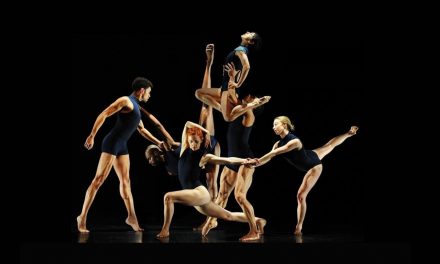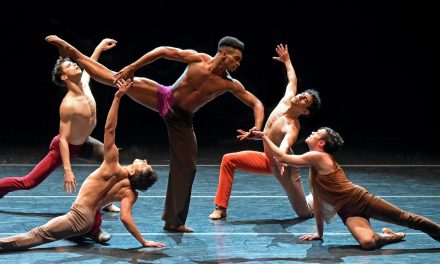Summers in L.A. are incomplete without a trip out to “The Bowl”. Los Angeles Philharmonic’s seasonal home, the beautiful amphitheater is ideal for catching a show with crisp visuals, thanks to its giant video screens. This setting therefore, was an ideal site for L.A. Dance Project (LADP)’s second iteration of Sergei Prokofiev’s Romeo and Juliet — an innovative live-streamed, location-shifting adaptation of the 1935 ballet (first titled Op. 64), which they premiered in October 2018.
Originally choreographed to fit the Walt Disney Concert Hall, some reworked scenes lost their magic when performed at the new locale. Others appeared refreshed and vividly enhanced the narrative. The new rendition may not have held the same stunning oomph for those who saw LADP’s first showing nine months earlier. However, the piece remains charmingly alluring. Artistic director Benjamin Millepied’s decision to present his production to a wider audience successfully helped the work gain more fans, piquing curiosity about its next stage of development.
The evening was split between LADP’s performance and a concert of Czech composer Antonín Dvořák’s Cello Concerto in B minor, Op. 104 featuring Spanish, award-winning cellist Pablo Ferrández. Backed by conductor Gustavo Dudamel and the L.A. Phil, Ferrández took the stage first and played Dvořák’s three-part melody, which he wrote for his wife’s sister who never returned his affections and died in 1895. Described by their titles “Allegro,” “Adagio, ma non troppo,” and “Finale: Allegro moderato,” the composition wavered between intense joy and profound sadness, each note dithering like a bee buzzing through the air. Ferrández’s skillfully highlighted the tonal shifts, articulating them through his smirks and longing looks as artfully as though his facial expressions were dictating the tune. L.A. Phil exquisitely framed the cello’s high and low sounds with bold trombones that managed not to overpower the soloist, and sweet clarinets that smoothly accompanied his playing. Serving as an introduction to Shakespeare’s tragedy, the music soulfully explored the full expanse of human emotions as they relate to love. The concerto’s conclusion was met with spectacular applause, hopefully signifying the beginning of a long career for Ferrández.
Romeo and Juliet took over the second half of the night with 2018’s opening night cast resuming their roles. This time, the ballet was not played in its entirety. Instead, the plot’s key moments were woven together to create one continuous, uninterrupted story. The action began with an expansion of Act I’s first scenes. Moments after Dudamel began leading the orchestra into the suite’s soft opening, Romeo (David Adrian Freeland, Jr.) appeared stage left, dreamily ambling his way toward the center with Millepied swiftly following behind, dutifully embracing his role as cameraman. Audible gasps were heard from audience members not expecting the show to be live-streamed. As with their debut, LADP remained tightlipped about their method, embracing an “if you know, you know” attitude for returning fans and keeping their still-welcome technique a surprise from first-time viewers.
Millepied’s choreography seemed even more innocent this second time around as the star-crossed lovers took time sitting and lying on the floor, gazing at the sky and all around them as though adjusting to their new environment. The boldest and most satisfying new component here included a mini-standoff between Mercutio (Aaron Carr) and Tybalt (Nathan B. Makolandra) who confronted each other several times throughout “The Fight” scene, finally kneeling and clasping hands in a solemn vow of death. This moment brilliantly foreshadowed The Bowl’s greatest design-based contribution to the ballet’s layout in a later segment including an expansion of their climactic fight. Initially just Tybalt’s covert murder by Romeo in an office building, Act II’s conclusion grew to include Mercutio’s downfall, and was staged in the aisles between the sectioned seating, as though taking place in the streets of Verona. This new setup gave off an authentic vibe completely in line with Shakespeare’s play. Millepied’s camerawork shined as he danced around the brawling men, capturing each woeful death and daring punch.
The most disappointing change by far was the Romeo and Juliet’s post-ball rendezvous, which felt underrated once it was revealed they were headed straight into a parking lot after leaving the stage. A far cry from the gorgeous Concert Hall gardens, the scene was further rendered awkward by a misstep during the chase. Millepied’s assistant accidentally got in the way of the shot, channeling a scene from Cops, wherein the pursuit felt more like a faux-dramatic hunt than a whimsical expedition.
The best part of this segment was the “Balcony Scene,” which played out on an escalator. Juliet (Janie Taylor)’s come-hither glances was coyly reminiscent of two teenagers making eyes at a strip mall — a good match for the couple’s casual clothes. However, despite the piece’s modern vibe, the new setting for the “Lovers’ Dance” — a road above The Bowl — did not have the same effect as the mirrored walls and green walkways explored last October. The romantic pas de deaux was less vibrant, and the duo’s secret meeting overly exposed for taking place in the middle of the street.
Likewise, “Juliet’s Funeral” was not as creepy with her body laying at the orchestra’s feet rather than in the catacomb-like trap room at the Concert Hall. Additionally, the funeral procession to her tomb seemingly felt out of place in regards to the forward-moving narrative, not leaving any gaps to let viewers’ minds fill in the story’s blanks. Its surprise factor however did play into Romeo’s shock of finding her lifeless.
In both cases, LADP did what they could with their surroundings. The couple’s chemistry remained strong enough throughout to extract a few fanciful sighs from viewers throughout the show. By its conclusion, all underwhelming feelings were erased thanks to the beautiful movement.
LADP’s journey with this classic remains interesting, with a future, full-length movie of the ballet shot all throughout the city showing plenty of promise as a must-watch event. The expansions were undoubtedly the best part of the evening and Dudamel’s flawless conduction of his orchestra — the crowning piece to an exciting and immersive dance experience I hope becomes a growing trend in L.A.
Written by Lara J. Altunian for LA Dance Chronicle, July 22, 2019
To learn more about L.A. Dance Project, click here.
For more information about the Hollywood Bowl, click here.
Featured image: LA Dance Project – Hollywood Bowl Dudamel Conducts Romeo and Juliet – Photos by Craig T. Mathew and Greg Grudt/Mathew Imaging



















